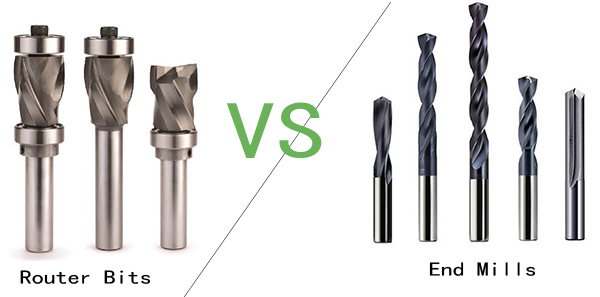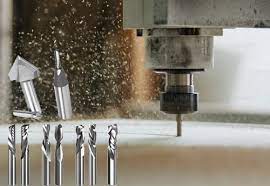In the intricate world of Computer Numerical Control (CNC) machining, the tools you utilize are as crucial as the skills you have acquired. Understanding the functionality, advantages, and appropriate use of various cutting tools is fundamental to successful CNC operations. This article delves into two essential cutting tools - End Mills and Router Bits - their differences, types, and applications in CNC machining.

Among the numerous tools in the CNC machining toolkit, End Mills and Router Bits have secured a special place. Both are fundamentally cutting tools but possess unique characteristics that differentiate their roles and applications in CNC machining.
An End Mill is a milling cutter widely employed in industrial milling applications. Unlike drill bits, which can only drill in the axial direction, an end mill can cut in all directions. This feature offers multi-axis machining capabilities, making it an indispensable tool in any CNC machinist's repertoire.
End Mills are primarily used for milling tasks such as slot cutting, contouring, and profiling. They can also execute other operations like drilling and plunging, making them multifaceted tools. Their robust design enables them to tackle a wide range of materials, from metals and plastics to wood.

Contrarily, Router Bits are designed with a specific purpose in mind. They are cutting tools that work with a router to hollow out an area in a hard work piece. The beauty of Router Bits lies in their ability to carve intricate and decorative designs, often seen in furniture and cabinetry.
Although Router Bits are usually associated with woodworking, they can also be used on other softer materials like plastic. They come in an extensive assortment of shapes and sizes, meaning they can create various profiles and cuts. However, unlike End Mills, which can cut in multiple directions, their usage is generally limited to lateral cutting.

Understanding the differences between End Mills and Router Bits is critical to ensure their effective usage in CNC machining. The key differences lie in their design, material compatibility, and functional roles.
While both tools are designed for cutting, the structure and robustness of an End Mill set it apart. Its capacity to handle different materials and cut in multiple directions is a testament to its versatility. Router Bits, on the other hand, are primarily designed for lateral cutting. They are often used for carving intricate and detailed work on softer materials like wood and plastic.
End Mills are compatible with a broader range of materials than Router Bits. They can efficiently handle metals, plastics, and wood. Conversely, Router Bits are mostly suited for softer materials, as they may not withstand the rigors of metal cutting.
Functionality-wise, End Mills has a broad spectrum of operations. They can perform various milling tasks, such as slot cutting, contouring, and profiling. Router Bits are best suited for creating specific shapes and decorative edges. They are the preferred tools for detailed work, such as decorative inlays and edgings.
When it comes to CNC machining, the choice of cutting tools significantly impacts your projects' outcomes. Two such critical tools are End Mills and Router Bits. Let's delve deeper into the various types of each.

Square End Mill: The most standard version, the Square End Mill, features a square tip that can create a flat-bottomed groove with sharp corners. It's especially useful for slotting, profiling, and roughing applications.
Ball Nose End Mill: Identified by its hemispherical tip, the Ball Nose End Mill is excellent for milling contoured surfaces, slotting, and pocketing. Its unique shape makes it ideal for situations where a profiled shape along the part's wall needs to be created.
Roughing End Mill: Also known as a hogging end mill, the Roughing End Mill is designed to quickly remove large amounts of material. Its wavy tooth form breaks the chips into smaller pieces, allowing for faster feed rates and cooler cutting.
Corner Radius End Mill: This type has a rounded corner at the tip, which enhances tool durability and reduces chipping. It is often used for operations that require a rounded, contoured bottom in the milling process.
Drill End Mill: A versatile tool, the Drill End Mill is designed for drilling, plunging, and milling. The special tip design allows it to perform these tasks without requiring a tool change, saving time and improving productivity.
Straight Router Bits: One of the most commonly used router bits, the Straight Router Bit, makes a straight cut into the material to form a groove or dado or to hollow out an area for a mortise or inlay.
Rabbeting Router Bits: These are designed with a spinning pilot bearing at the tip. Rabbeting Router Bits cut a shoulder, or "rabbet," on the edge of the work piece and are frequently used to join pieces of wood together.
Flush Trim Router Bits: Flush Trim Router Bits are used to trim the edges of material flush with the edge of another. They are guided by a pilot bearing the same diameter as the cutter.
Edge Forming Router Bits: These bits are typically used to cut a decorative edge. Examples include round-over bits that round the edge of a work piece and cove bits that cut a concave quarter-circle into a piece of material.
Specialized Router Bits: As the name suggests, these bits perform specific tasks. For example, stile-and-rail router bits shape the frame pieces in panel doors, and drawer-lock router bits create interlocking joints in drawer fronts.
Understanding these diverse types of End Mills and Router Bits is crucial for effectively operating your CNC machine, helping you achieve optimal results for your specific project requirements.
End Mills and Router Bits used in CNC machining are extensive due to their versatility.
End Mills are typically employed when there is a need for producing holes, slots, or pockets with a flat bottom. They are also used when the surface to be machined may be contoured or when the part's profile requires detailing.
Router Bits, on the other hand, are largely used for detailed and decorative work. They are commonly used in edging, trimming, veining, and grooving in softer wood and plastic. With an assortment of profiles, from rounded to V-shaped, they can create intricate designs on work pieces.
In CNC machining, deciding which tool to use for a project can profoundly influence the quality of your work and the longevity of your machine. Therefore, choosing the correct tool, an End Mill or a Router Bit is vital based on a few critical parameters.
Each tool in CNC machining is designed to work optimally with specific materials. For instance, End Mills, known for their robustness, can cut through harder materials like steel or titanium but can also efficiently handle plastics and wood. On the other hand, Router Bits are ideal for softer materials like wood and plastic, often used for intricate detailing and decorative work. Using a tool on an incompatible material may lead to inefficient machining and possible tool damage.
Different tasks necessitate different tools. If you want to do milling tasks such as slot cutting, contouring, and profiling, an End Mill would be the best choice. It's versatile and can cut in multiple directions. Conversely, a Router Bit would be the preferred tool if you need to carve intricate designs or do lateral cutting only.
The size and shape of the cut you wish to create can also dictate the tool you should use. Ball Nose End Mills, for instance, are perfect for tasks where a profiled shape along the part's wall is required. In contrast, if you need to create a straight cut or form a groove, Straight Router Bits would serve you better.
It's crucial to remember that not all tools are compatible with every CNC machine. Be sure to check your machine's specifications before choosing a tool. Some machines might not be designed to handle the rigidity of an End Mill, while others may not accommodate the specific design of a Router Bit.
Finally, the cost and availability of the tools also come into play. While End Mills are generally more expensive due to their versatile and heavy-duty nature, Router Bits can be a cost-effective choice for projects involving softer materials and intricate designs.
Remember that using the right tool ensures a high-quality finish, prolongs your machine's life, and enhances safety. Take the time to analyze the requirements of your task and make an informed choice between an End Mill and a Router Bit. And remember, even the highest-quality tool can fail if not used correctly, so always follow best machining practices and safety protocols.
As the saying goes, "The right tool for the right job." a mantra frequently endorsed by pragmatic thinkers rings especially true when it comes to CNC machining. The significance of recognizing this tenet and putting it into practice cannot be overstated as it sets you up to competently oversee all relevant processes, thereby ensuring seamless execution of diverse endeavors marked by impressive outcomes withstanding scrutiny from one and all.
Ultimately, your knowledge, skills, and judgment are your most important tools. So, keep learning, keep experimenting, and always strive for perfection. After all, the journey of CNC machining is a lifelong adventure filled with constant learning and growth.
In competitive environments like that of CNC machining. Making wise decisions about which tools to use can determine whether you sink or swim. Choosing between End Mills and Router Bits involves more than superficial differences - in-depth knowledge about their specific applications will ensure better outcomes for any project. The right tool affects product quality and ensures that machinery performs optimally over time.
Selection of the right tool depends on various factors, including the type of material you're working with, the precision required, and the specific task at hand. For example, End Mills are better for working with metals and multi-directional cuts, while Router Bits are better suited for detailed work on softer materials.
The key differences lie in their design, material compatibility, and functional roles. While End Mills can handle various materials and cut in all directions, Router Bits are designed for lateral cutting and detailed work on softer materials.
Regular inspection for wear and tear, proper cleaning after use, using them for their intended purpose, and storing them properly can significantly extend their lifespan.
Using the right tool for the right job directly impacts machining efficiency. For example, using an End Mill where a Router Bit is required may result in longer machining times and less precise results, and vice versa.
An example of using an End Mill would be when you need to create a slot with a flat bottom in a piece of metal or when you have to cut in multiple directions.
A CNC machine uses a coded programmed instruction and converts it into physical motion to machine the material. The End Mills and Router Bits are the cutting tools that interface with the material based on this instruction.
For detailed and decorative work on softer materials like wood, Router Bits are the preferred choice due to their design and available variety.
The three common types of End Mills are Square End Mills, Ball Nose End Mills, and Roughing End Mills.
Two common Router Bits are Straight Router Bits and Rabbeting Router Bits.
An End Mill should be used when you're working with harder materials like metals or when you need multi-directional cuts.
Router Bits are typically used for detailed and decorative work on softer wood and plastic.
They are used to prevent inefficiency in the CNC machining process. Using the right tool for the right job helps prevent the waste of time and resources.
Using the correct tool not only ensures efficient and precise machining but also contributes to the longevity and performance of your CNC machine.
Understanding their differences helps you decide which tool to use for a specific task, ensuring efficient and effective CNC machining.